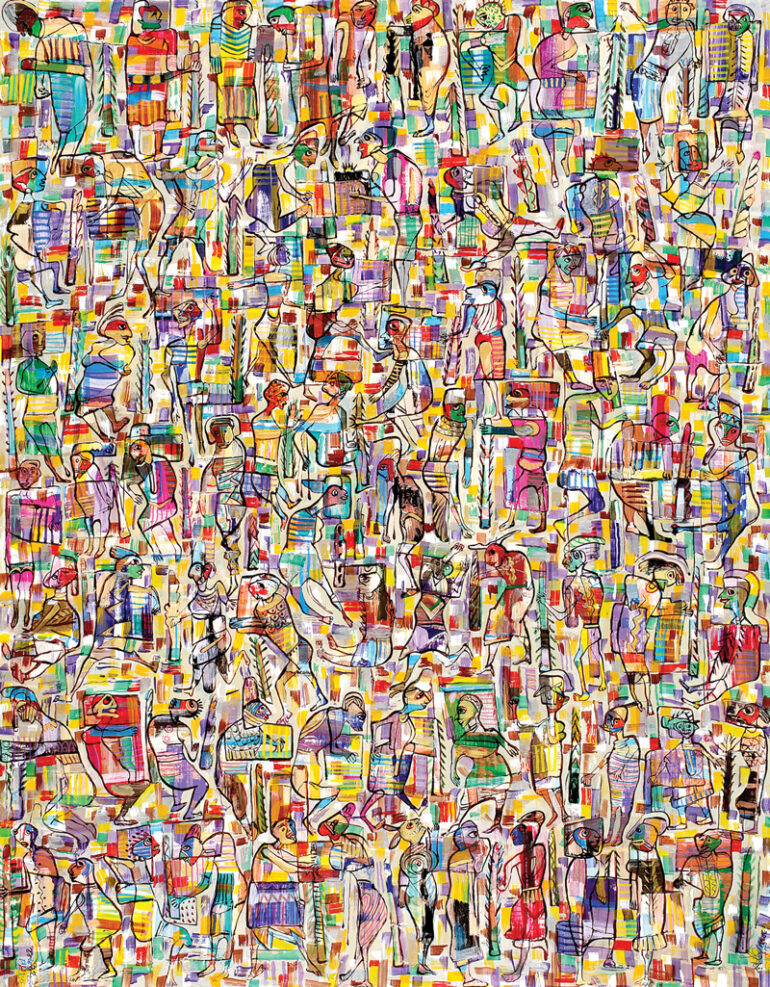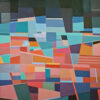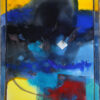Fine arts have been a truly philosophical field for as long as a century, after years of being condemned to simulate the sensible, and to serve as the copy that will never mount to true existence level. This is how art philosophy went on back since the days of Plato to the days of prohibiting images and the war on icons, up to the days of favoring poetry over other arts, including painting, in German romanticism especially. The first records of this modern discovery of the importance of painting can be traced back to Heidegger’s book “The Origin of the Work of Art”, which will also have different advances later in philosophical books, such as “Eye and Mind” by Maurice Merleau-Ponty (1961), “The Truth in Painting” by Derrida (1978), and “The Logic of Sense” by Deleuze (1981). … Discovering the philosophical importance of fine arts was mainly based on a core thesis, initially embodied in a statement by Heidegger, when he said “It is within the impact we see the truth occurrence in work, and referencing van Gogh’s painting of shoes was an attempt to name that occurrence”. This means that a painting is an attempt to capture truth being born, the artist is no longer hunting ghosts, instead, he’s creating an area for the truth itself, which is in some way an area for philosophy… because philosophy can only be born from outside philosophy… this is what a thesis by Gilles Deleuze, the French philosopher, is announcing “It is because philosophy is born or produced outside by the painter, the musician, the writer, each time that the melodic lines draws along the sound, or the pure traced line colour, or the written line the articulated voice..”1
Yet, it seems that the one who granted fine arts the highest ontological position is “The Eye and Mind” book by the contemporary French philosopher Maurice Merleau-Ponty. In which, the artist could find himself at a level higher than science itself, since science flies around the world but abandon its habitat once it is turned into epistemological topics. This is when the artist, alone, could consume the raw pure meaning of existence, and the artist alone is the one with the right to “observe all things”. When there is a world, the painter is born intertwined with it as if Art is the embodiment of the world, and it is the artist’s mission to unravel the invisible unperceived and troubled being in our bodies, the being through which we recognize the world, and in which we stay near the color, the depth, the line, the light, the size, and the shape, as if we were all one whole fabric of being.
In what sense is fine art considered a restoration of the world, in its genuine form before cognition? How shall the artist restore our relation to the being by freeing it from the dominance of the epistemological perception that reduces into mere topics to be trapped in laboratories? How could Art innovate so closely to objects so it could retype the dialectic of the invisible and the invisible via theories of entanglement and fusion being?
These are the problematic concepts that we will try to address in this article via a philosophical approach aiming to reside within the greatest texts of contemporary art philosophy, following an intellectual method of questioning, then analyzing and unfolding…
In that there is only a world:
The world has existed, in its original state, long before our perception. it represents the direct presence of things in their sturdiness and depth, and in their colors, lines, and volumes… our perception of them is basically a sensible one, in the sense of touching, approaching, and living within things as they appear to our basic consciousness. this is the range of meanings suggested by Merleau-Ponty’s philosophy since his book (Phenomenology of Perception) in 1945, to his book (The Eye and the Mind) in 1961 published after his death. so, what meaning does the sensible perception carry then? how our perception of the world is done, and what does it have to do with fine arts? to answer these questions, we will start at the concept of perception which Merleau-Ponty considered the starting point of his thesis in his book, which was his doctoral dissertation. in this book introduction, the philosopher considers that we haven’t yet unraveled the meaning of sensation, in the sense that, opposed to what we think, “nothing could, in fact, be more confused.”2
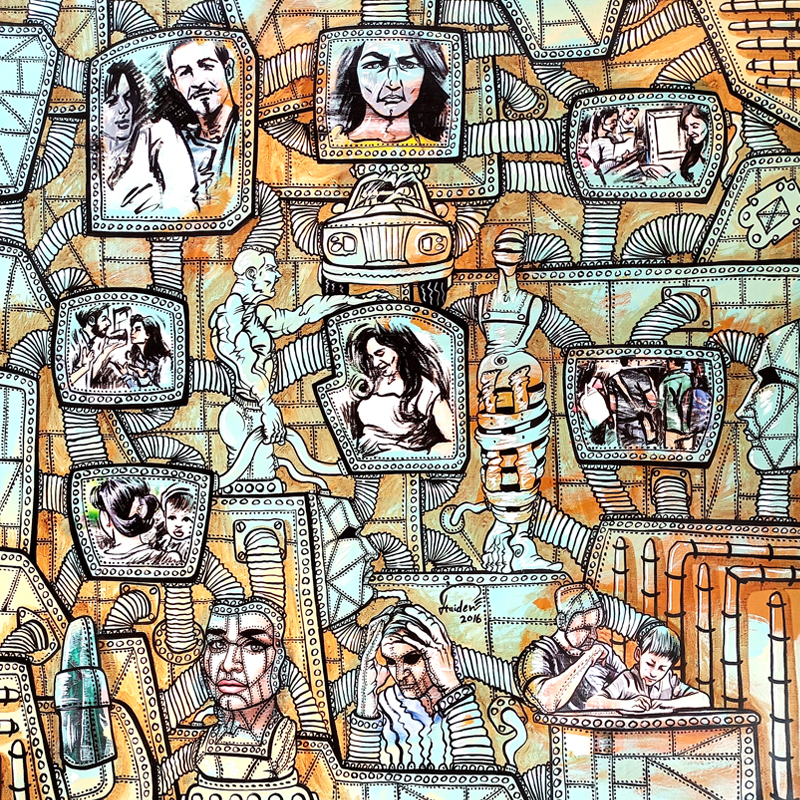
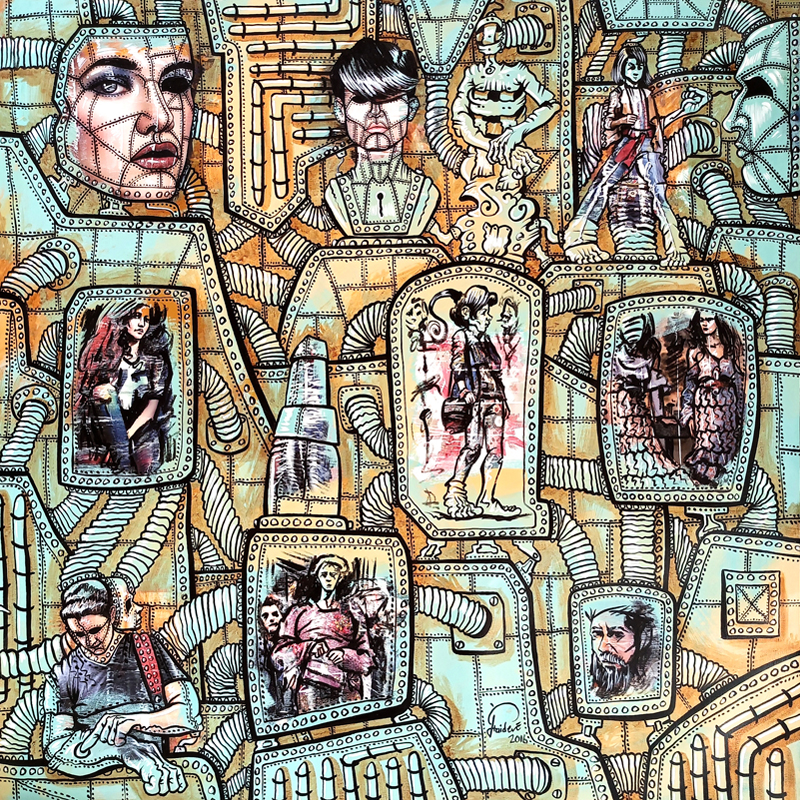

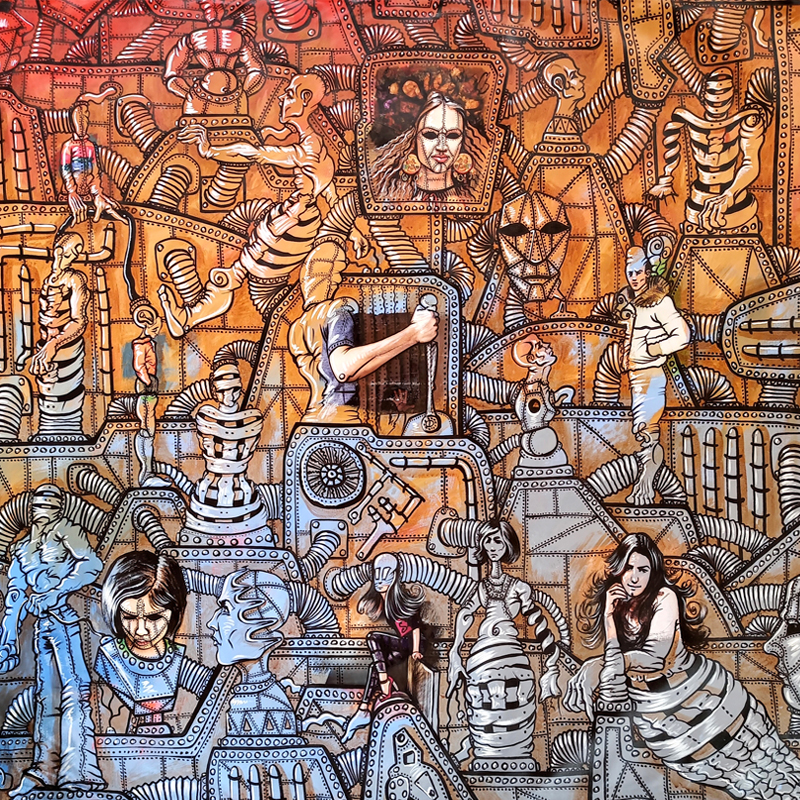
Haidar ALqassam: “Dream Factory”, Acrylic & collage on Canvas, 100×100 cm each, 2016, courtesy of the Artist.
In order to define this concept, Merleau-Ponty suggests an amusing artistic phrasing so he says: ” The sensation is the greyness which, when I close my eyes, surrounds me, leaving no distance between me and it…”3. in other words, sensation is born the moment we meet the sensed when it stops being just a topic thrown out alone in the world. the sensation is born in colors with them being “the place where our brain meets the world”. this, the sensed is liberated from its position as something put in the world, isolated from the sensing self, and reaching a point of decisive theoretical transformation around this concept that is essential to arts in general, and to painting in particular, since it is so attached to things, and it accompanies those things while they’re entering the visible range. but, how do things break into this visual field? how do they leave their state of being no more than things put in the world, and exist conditionally in the presence of a sensing or precepting self, into visible things in what is achieving of the world being? this stays depending on our reconsideration of our perceptions around the sensation and the sensed, and the relation with the world, the body, the vision, and the game of the visible and the invisible.
Sensation, as a start, is the net of entangled and intertwined links between sensed objects. Merleau-Ponty provides another example of that, he says ” Let us imagine a white patch on a homogeneous background. All the points in the patch have a certain ‘function’ in common, that of forming themselves into a ‘shape’ … each point in its turn can be perceived only as a figure on a background …”4 the point of that is to prove that the things we sense are all ways of the world Being, they’re not senses in the lower level of recognition. for that, we cannot give art a core place within philosophy unless we liberate our relationship with the world from scientific perception for it is simply not enough to create this closeness with the Being.
How the artist restores our relationship with the world:
The world has been isolated away from us, turned into mere topics that we can control by turning them into mathematical equations. This is the modern science doing, to our world, according to philosopher Merleau-Ponty, when he stated in the first sentence of his book “Eye and Mind” that “Science manipulates things and gives up living in them”5 so science, in that sense, cannot live within the things because it reduces them into models, marks, and equations “as if everything that is and has been was meant only to enter the laboratory”6 It is then about necessarily freeing the things from the modern epistemological perception, based on a cognitive Cogito claiming that man could be “The master and owner of the world”. a perception believes that we yet have the possibility to reduce our relation to existence in the metaphysical duet based on the knowledgable-self left far, lonely isolated at a distance from us, and from its own skin and aroma. This is why science needs to rectify its relationship with the world, and stop looking at things from above, and descend into what Merleau-Ponty calls a pre-theme of us, of our knowledge, of our claims, and our illusions. this theme is the world itself, and it was unraveled in the visible space, into which the artist masters entering. it is the visible merging with the invisible, not being an opposite of it. in that sense, Merleau-Ponty provides the artist with this ontological honor of incubating this experience of merging with the world, by restoring the artistic meaning as opposed to the scientific facts, thus dictating a theory of vision opposing to the classic knowing self that created a huge gap between us and the world’s objects. in that, he wrote “Now art, especially painting, draws upon this fabric of brute meaning… Art and only art does so in full innocence… Only the painter is entitled to look at everything without being obliged to appraise what he sees…”7 the artist release himself from knowing things, as it is enough for him to bring them into the visible space where they can fulfill their true meaning of their existence, which is to be present in this world. The artist here lends his body to the world so that the world becomes painting.
The body here is not a bundle of functions or a system of organs, it is “Intertwining and vision”. Here we must stop for a moment at the third eye concept, on which Merleau-Ponty places great importance for art philosophy since it “Sees the world, and what it would need to be a painting, sees what keeps a painting from being itself, sees – on the palette – the colors awaited by the painting, and sees, once it is done, the painting that answers to all these inadequacies…”8, the third eye looks from within because it is what “It gives visible existence to what profane vision believes to be invisible”9 and the risk of science turning things into mere topics is our loss of the world, i.e. losing our familiarity with it.
It is more about a philosophic theory of vision, as if it were a puzzle that escapes our scientific knowledge of it, yet “the painter, any painter, while he is painting, practices a magical theory of vision”10 This theory finds its initial validation in the visible and the invisible play. Cézanne who paints “Mont Sainte-Victoire” is painting the mountain itself, commanded by the artist to “unveil the means, visible and not otherwise, by which it makes itself mountain before our eyes. Light, lighting, shadows, reflections, color…”11. Mont Sainte-Victoire was “visible” as a neglected topic in some isolated place, yet it wasn’t “visible” for a see-er who considers that “The visible world and the world of his projects are both total parts of the same Being”12 and what the painter does is awakening the vision so that the visible arises from within the invisible itself.
Then why the painter seeks to awaken vision? He does so in order to have something arising from the flesh of the world to constitute the visible that we have lost under the veil of cumulative knowledge. The play of the visible and the invisible arises from the things themselves when art manages to restore them in their mere visibility, as a sum of sensible connections lodged in our bodies, which are our channel of recognizing the world. What makes painting possible is this strange play of concurrence between the see-er, the visible, and the invisible, all against a fabric of one whole Being. This all happens within the relationship between painting and the body.
The Body and the Ontology of Art
There is another mystery that inhabits our bodies. However, philosophy is not always obliged to solve mysteries, only describing them. philosophers aren’t necessarily witnesses of the truth every time. Hence, we’re obliged to unravel the ambiguity and mysteries that haunt us and circle us. This is what Merleau-Ponty tries to unravel the mystery of vision, the mystery of body, and the mystery of space. These mysteries are generated from the mystery of the body, in particular, in terms of what is the vision orbit and the place orbit which “evades our attempts to survey it from above”13
The mystery of the body is mainly represented by the body being both the see-er and the visible at the same time. The body keeps on immersing in the visible as it is the one that sees it, yet it cannot obtain what it sees, only approach it by vision. We don’t possess the world within our vision, all we ask for is the familiarity with it, and immersion in it as it is our first and only environment, which is the thing that painting techniques try to embody so that “Quality, light, color, depth, which are there before us, are there only because they awaken an echo in our bodies and because the body welcomes them”14
This is how the ontology of Art is discovered as an embodiment of objects entities in their early innocence. It is an ontology based on a new perception of painting as the “meeting of all the aspects of Being… Because depth, color, form, line, movement, contour, physiognomy are all branches of Being”15. Painting is not a simulation, resemblance, image, nor a topic. Art is no longer that artificial relation to some place. A painting is not a scene depicting a thing, what the painter accomplishes is “This inner animation, this radiation of the visible… the words depth, space, and color”16. The painter is the one who enables the line to dream, as Merlaeau-Ponty writes about one of his favorite artists “Perhaps no one before had let a line muse”17 and it is the reason that “painting is an art of space”18. There is something that invades the painter’s body in every painting, it is the vision that does not allow for anything to escape the grasp of the Being. This is the “Ontological formula of painting”19, one that comes to deter the world away from its alienation.
Conclusion:
We will conclude by mentioning a few remarks on the aesthetics of art, which we can sum up in four:
First remark: Art is a form of our restoration of the world, before the dominance of science over it, as embodied in Cézanne Apples or Van Gogh’s wheat field…
Second: The artist is born within the things captured by his brush and colors.
Third: Art does not require one to know things, it instead awakens them and saves them from their silent situation, and places them there amidst the visible. It listens to the sounds of silence and rescues them from neglect and fading.
Fourth: Art deters the Being away from its alienation by providing it with the invisible light in it, and they, in turn, open up a new world and unleash the horizon for the world to know, and for the Being to grow vast…
References
1. Deleuze, Gilles. & Parnet, Claire. (1977). Dialogues. Paris : Flammarion, Page 74.
2. Merleau-Ponty, Maurice, 1908-1961. Phenomenology of Perception. London : New York :Routledge & K. Paul; Humanities Press, 1974. page 3.
3. Ibid.
4. Ibid. page 4.
5. Merleau-Ponty, M. (1964a). Eye and Mind. page 1.
6. Ibid, page 2.
7. Ibid, page 3.
8. Ibid. page 7.
9. Ibid. page 7.
10. Ibid. page 7.
11. Ibid. page 8.
12. Ibid. page 4.
13. Ibid, page 15.
14. Ibid, page 5.
15. Ibid, page 28.
16. Ibid, page 22.
17. Ibid, page 23.
18. Ibid, page 24.
19. Ibid, page 27.
A researcher in philosophy, and a critique of aesthetics. professor in the Philosophy department at The Higher Institute of Human Sciences of Tunis, with a specialization in: Western modern philosophy and modern aesthetics.

